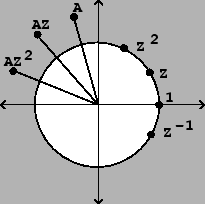




Next: Time shifts and phase
Up: Complex numbers
Previous: Complex numbers
Contents
Index
Recall the formula for a (real-valued) sinusoid from Page
![[*]](file:/usr/local/share/lib/latex2html/icons/crossref.png) :
:
This is a sequence of cosines of angles (called phases) which increase
arithmetically
with the sample number  . The cosines are all adjusted by the factor
. The cosines are all adjusted by the factor  .
We can now rewrite this as the real part of a much simpler and easier to
manipulate sequence of complex numbers, by using the properties of their
arguments and magnitudes.
.
We can now rewrite this as the real part of a much simpler and easier to
manipulate sequence of complex numbers, by using the properties of their
arguments and magnitudes.
Figure 7.2:
The powers of a complex number  with
with  , and the same
sequence multiplied by a constant
, and the same
sequence multiplied by a constant  .
.
 |
Suppose that a complex number  happens to have magnitude one and
argument
happens to have magnitude one and
argument  , so that
it can be written as:
, so that
it can be written as:
Then for any integer  , the number
, the number  must have magnitude one as well
(because magnitudes multiply) and argument
must have magnitude one as well
(because magnitudes multiply) and argument  (because arguments add).
So,
(because arguments add).
So,
This is also true for negative values of  , so for example,
, so for example,
Figure 7.2 shows graphically how the powers of  wrap around
the unit circle, which is the set of all complex numbers of magnitude one.
They form a geometric sequence:
wrap around
the unit circle, which is the set of all complex numbers of magnitude one.
They form a geometric sequence:
and taking the real part of each term we get a real sinusoid with
initial phase zero and amplitude one:
Furthermore, suppose we multiply the elements of the sequence by some (complex)
constant  with magnitude
with magnitude  and argument
and argument  . This gives
. This gives
The magnitudes are all  and the argument of the
and the argument of the  th term is
th term is
 , so the sequence is equal to
, so the sequence is equal to
and the real part is just the real-valued sinusoid:
The complex number  encodes both the real amplitude
encodes both the real amplitude  and the initial phase
and the initial phase  ; the unit-magnitude complex
number
; the unit-magnitude complex
number  controls the frequency which is just its argument
controls the frequency which is just its argument  .
.
Figure 7.2 also shows the sequence
 ;
in effect this is the same sequence as
;
in effect this is the same sequence as
 , but amplified and
rotated according to the amplitude and initial phase. In a complex
sinusoid of this form,
, but amplified and
rotated according to the amplitude and initial phase. In a complex
sinusoid of this form,  is called the
complex amplitude.
is called the
complex amplitude.
Using complex numbers to represent the amplitudes and phases of sinusoids can
clarify manipulations that otherwise might seem unmotivated. For instance,
suppose we want to know the amplitude and phase of the sum of two sinusoids
with the same frequency. In the language of this chapter, we let the two
sinusoids be written as:
where  and
and  encode the phases and amplitudes of the two signals.
The sum is then equal to:
encode the phases and amplitudes of the two signals.
The sum is then equal to:
which is a sinusoid whose amplitude equals  and whose phase equals
and whose phase equals
 . This is clearly a much easier way to manipulate amplitudes
and phases than using properties of sines and cosines. Eventually, of course,
we will take the real part of the result; this can usually be left to the
end of whatever we're doing.
. This is clearly a much easier way to manipulate amplitudes
and phases than using properties of sines and cosines. Eventually, of course,
we will take the real part of the result; this can usually be left to the
end of whatever we're doing.





Next: Time shifts and phase
Up: Complex numbers
Previous: Complex numbers
Contents
Index
Miller Puckette
2006-12-30
![]() :
:
![]() happens to have magnitude one and
argument
happens to have magnitude one and
argument ![]() , so that
it can be written as:
, so that
it can be written as:
![]() ;
in effect this is the same sequence as
;
in effect this is the same sequence as
![]() , but amplified and
rotated according to the amplitude and initial phase. In a complex
sinusoid of this form,
, but amplified and
rotated according to the amplitude and initial phase. In a complex
sinusoid of this form, ![]() is called the
complex amplitude.
is called the
complex amplitude.